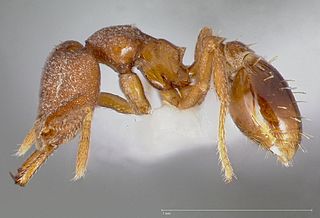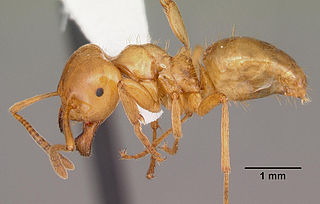
Dolichoderinae is a subfamily of ants, which includes species such as the Argentine ant, the erratic ant, the odorous house ant, and the cone ant. The subfamily presents a great diversity of species throughout the world, distributed in different biogeographic regions, from the Palearctic, Nearctic, Afrotropical region and Malaysia, to the Middle East, Australian, and Neotropical regions.

Cephalotes is a Neotropical genus of tree-dwelling ant species, commonly known as turtle ants. All appear to be gliding ants, with the ability to "parachute" and steer their fall so as to land back on the tree trunk rather than fall to the ground, which is often flooded.

Monomorium is a genus of ants in the subfamily Myrmicinae. As of 2013 it contains about 396 species. It is distributed around the world, with many species native to the Old World tropics. It is considered to be "one of the more important groups of ants," considering its widespread distribution, its diversity, and its variety of morphological and biological characteristics. It also includes several familiar pest species, such as the pharaoh ant and the flower ant.

Strumigenys is a genus of ants in the subfamily Myrmicinae.

Prionomyrmex is an extinct genus of bulldog ants in the subfamily Myrmeciinae of the family Formicidae. It was first described by Gustav Mayr in 1868, after he collected a holotype worker of P. longiceps in Baltic amber. Three species are currently described, characterised by their long mandibles, slender bodies and large size. These ants are known from the Eocene and Late Oligocene, with fossil specimens only found around Europe. It is suggested that these ants preferred to live in jungles, with one species assumed to be an arboreal nesting species. These ants had a powerful stinger that was used to subdue prey. In 2000, it was suggested by Cesare Baroni Urbani that the living species Nothomyrmecia macrops and a species he described both belonged to Prionomyrmex, but this proposal has not been widely accepted by the entomological community. Instead, scientists still classify the two genera distinctive from each other, making Nothomyrmecia a valid genus.

Procryptocerus is a Neotropical genus of gliding ants, with the ability to "parachute" by steering their fall if they drop off of the tree they're on.

Dolichoderus is a genus of ants found worldwide.

Typhlomyrmex is a genus of ants in the subfamily Ectatomminae and the sole member of the tribe Typhlomyrmecini. Known from the Neotropics, the genus has a wide distribution. Some species are restricted in range, while for example Typhlomyrmex rogenhoferi is known from southern Mexico to northern Argentina. Little is known about their biology.
Myrmecia ferruginea is an Australian ant which belongs to the genus Myrmecia. This species is native to Australia. The Myrmecia ferrguinea has been notably distributed in Queensland.
Myrmecia varians is an Australian ant which belongs to the genus Myrmecia. This species is native to Australia. The Myrmecia varians is one of the most distributed ants in the country, with the species being observed in every single state and territory except for Tasmania. Myrmecia varians was first described by Mayr in 1876.

Arnoldius flavus is a species of ant of the genus Arnoldius, one of only three species described in it. Native to Australia, it was described by Crawley in 1922.
Arnoldius scissor is a species of ant, one of three species described in the genus Arnoldius. Native to Australia, it was described by Crawley in 1922.

Lasius interjectus, or larger yellow ant, is a species of ant belonging to the genus Lasius, and was formerly a part of the genus Acanthomyops. Described in 1866 by Mayr, the species is native to the United States.

Brachyponera is genus of ants in the subfamily Ponerinae.

Ectomomyrmex is a ponerine genus of ants found in Asia and Australia. Little is known about their biology, but they seem to be generalist predators of arthropod prey.
Dolichoderus scrobiculatus is a species of ant in the genus Dolichoderus. Described by Mayr in 1876, the species is endemic to Australia.

Camponotus herculeanus is a species of ant in the genus Camponotus. First described as Formica herculeana by Linnaeus in 1758, the species was moved to Camponotus by Mayr in 1861.

Camponotus floridanus, or Florida carpenter ant, is a species of ant in the genus Camponotus. First described as Formica floridana by Buckley in 1866, the species was moved to Camponotus by Mayr in 1886.















